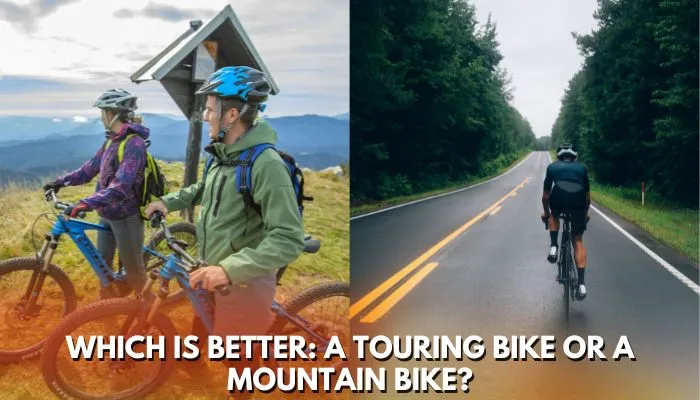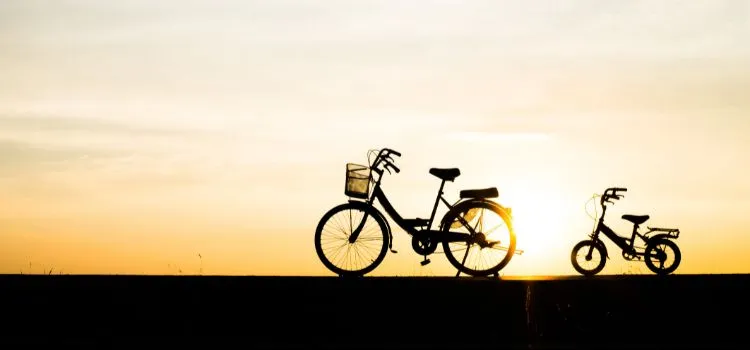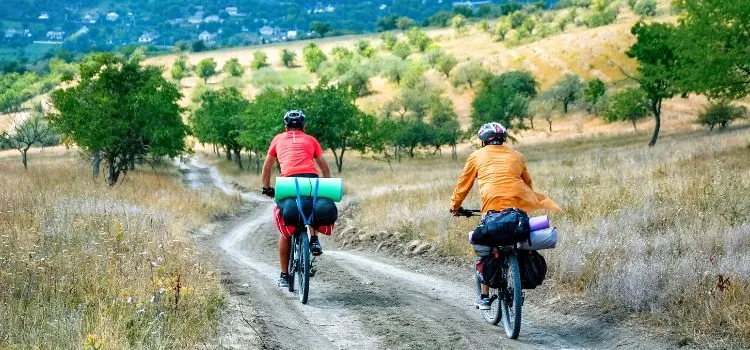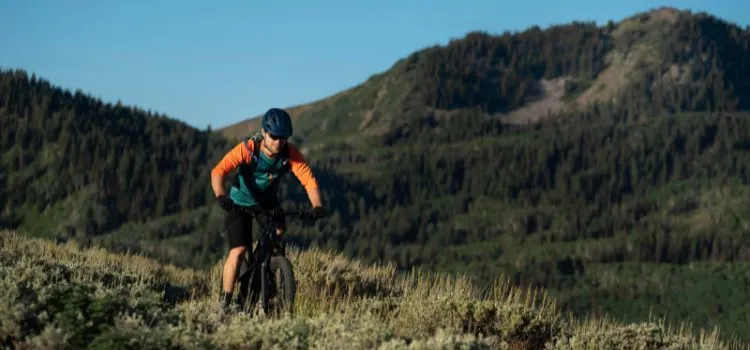Which Is Better: A Touring Bike Or A Mountain Bike?

Cycling is an excellent cardiovascular exercise. Dedicated bike lanes or wooded paths can be found in a growing number of places. It’s an enjoyable, effective method to view the attractions. You enjoy exploring new places on your bicycle and seeking fresh adventures. The question is, how can you know which kind of bike is best for you?
Table of Contents
Short Answer
What is the distinction between a touring bike vs mountain bike? Touring bicycles are made for people who want to ride their bikes for several days. Touring bikes are mainly designed to accommodate a lot of gear. On the opposite end of the spectrum, mountain bikes are made to go only a few kilometers down mountainsides, rocky terrain, and over barriers for a fascinating and thrilling ride.
The major distinctions between touring bikes as well as mountain bikes will be examined in-depth in this article. It is unlikely that you would want to race down a mountain bike route on your touring cycle, even though you might be able to utilize your mountain bike for transportation.
Touring Bike Vs Mountain Bike
Touring bikes and mountain bikes are made for different uses, and each of them has its own strengths, special features, and weaknesses.
Touring bikes are basically intended for long-distance travel on paved as well as unpaved paths. They generally have a much more straight riding posture, wide bike tires, and a long wheelbase as compared to road bikes.
This makes them much more comfortable over longer distances. They also have more attaching points for racks and bike panniers, which are used to carry items for long day trips. In general, touring bikes are not as fast as road bikes. But they are much more comfortable and stable over long distances.
Mountain bikes, on the other extreme, are designed for off-roading surfaces. They have wide bike tires with aggressive treading patterns, strong suspension systems for shock absorption, and a straight riding posture to offer better handling on rough terrain. They are bulkier and slower than touring bikes. However, they are much better suited for tough terrain and hard trails.
Touring Bike Vs Mountain Bike: Main Differences

There are several major differences between touring bikes and mountain bikes. Here are some of them mentioned below:
- Framework geometry:
Touring bikes are basically intended with a long wheelbase and a straight riding posture. This provides a much more comfortable and stable bike ride over longer distances. Mountain bikes, on the other extreme, have a short wheelbase and an aggressive riding posture. This offers much better control and maneuverability on tough trails.
- Bike tires:
Touring bikes have much wider and flatter tires, which enable better traction and stability on paved as well as unpaved paths. Mountain bikes, on the other extreme, have wide and knobby bike tires, which help with superior grip on loose and challenging terrain.
- Suspension system:
Touring bikes generally do not have strong suspension systems, but if they do, they have short suspension to decrease weight. Mountain bikes, at the same time, have great suspension systems that have shock absorption and provide great control on tough terrain.
- Bike brakes:
Touring bikes generally have rim brakes and disc brakes, which enable good halting power on paved as well as unpaved roads. Mountain bikes usually have hydraulic installed disc brakes, which enable better stopping ability and handling on technical paths.
- Gearing system:
Touring bikes usually have a wide range of gears, which allows riders to tackle steep hills and long distances with ease. Mountain bikes also have a wide range of gears, but they are designed for steep climbs and technical descents.
- Weight:
Touring bikes are usually bulkier as compared to mountain bikes since they are designed to occupy more gear and have a stronger framework. At the same time, Mountain bikes are intended to be lighter in weight and easily maneuverable for technical paths.
- Extra accessories:
Touring bikes generally have much more attaching points for racks and bike panniers, which are used to transport gear for long day trips. Mountain bikes basically have less mounting points. However, they often have other accessories, such as water bottle carriers, lights, and fenders, to make bike riding on tough trails easier.
All in all, touring and mountain bikes are intended for different yet unique purposes and ground types. While they may also share some similarities, the major differences in frame geometry, tires, suspension, brakes, gearing, weight, and accessories make them different from each other.
Similarities Between Touring Bike And Mountain Bike:

Touring bikes and mountain bikes are made for different purposes and ground types. However, they do share some similarities. Here are a few of them mentioned below:
- Durability:
Both touring bikes and mountain bikes are intended to be strong and withstand tough terrain. They are manufactured with firm frames and parts that can handle the requirements of long-distance rides or tough trails.
- Versatility:
Touring bikes and mountain bikes are designed for several ground types; they both provide a great level of versatility. For instance, touring bikes can handle unpaved paths and some light off-roading use. At the same time, mountain bikes can be employed for commuting or riding on smooth terrain.
- Level of Comfort:
Both touring bikes and mountain bikes deliver a great level of comfort that is not accessible on road bikes. Touring bikes have straight riding posture, which is much more comfortable for many riders. On the other hand, mountain bikes have strong suspension systems that absorb shock and deliver a smoother trip.
- Braking system:
While the type of braking system used on touring bikes and mountain bikes might differ, both kinds of bikes offer reliable and efficient braking abilities. This is quite essential for safety and handling, especially when riding on challenging ground or carrying a bulk.
- Customization:
Both touring bikes, as well as mountain bikes, can be personalized to suit personal preferences and requirements. This can involve changes to the bike handlebars, seats, bike pedals, or parts to enhance comfort, performance, as well as aesthetics.
Overall, touring bikes and mountain bikes both have different purposes. Yet they share some commonalities that make them great choices for bike riders.
Who Should Ride A Mountain Bike?

Mountain bike riding is a well-known outdoor activity that is cherished by people of all age groups and skill levels. If you love being outdoors, doing exercise, and exploring outdoor surroundings, then mountain biking may be the perfect activity for you.
Mountain biking is preferred by newbies as well as experienced riders, and it can be the perfect way to have physical movements, relieve stress, and enjoy. If you are new to mountain biking, it is important to begin with easy grounds and work your way up to more tough ones as your skills enhance.
Mountain bikes can also be a perfect activity for families, groups of friends, or people looking to introduce new people with similar preferences. The majority of mountain bike trails have a community of bike riders who love sharing tips, acrobats, and ground information with other people.
Ultimately, anyone who loves being active, wants to explore the outdoors, and experiences the thrill of riding off-road will definitely enjoy mountain bike riding.
Who Should Ride A Touring Bike?
Touring bikes are designed for long-distance traveling and are perfect for people who love to ride over extended periods of time, carrying a great deal of gear. As such, touring bikes can be an ideal choice for a wide variety of people, such as:
- Adventure bikers:
Those who want to explore new areas and push their limits might enjoy touring bikes. This is because they are designed to handle a vast range of grounds and climate conditions.
- Commuters:
Those who utilize their bike as a primary means of transportation can take advantage of the durability and long-lasting feature of a touring bike. They have the ability to carry heavy loads and can withstand the rides of daily use.
- Senior and physically disabled bike riders:
Those who might have any physical disability or limitations that require a more comfortable and stable ride would love the features of a touring bike. They might include features such as the capability to carry bike gear and the relaxed geometry that reduces overall stress on the body.
In general, touring bikes are an ideal choice for people who want to ride for extended periods of time. Moreover, you can carry gear and prioritize comfort and stability over higher speed and agility.
Touring Vs. Mountain Bike: Which Bike Is Better?
People of every age and level of ability can engage in the well-liked outdoor pastime of mountain biking. Mountain biking can be a fantastic hobby for you if you like to spend time outside, get some exercise, and explore the outdoors.
Beginners and seasoned riders alike can enjoy mountain biking, a fantastic way to stay active, decompress, and have a good time. When you first start mountain biking, it’s crucial to start on easier terrain and progressively advance to more difficult ones as your abilities develop.
Families, groups of friends, and individuals wishing to meet new people with similar interests can all benefit from mountain biking as a terrific hobby. A community of mountain bikers on many routes appreciate imparting advice, techniques, and trail knowledge to other riders. In the end, mountain biking may be enjoyed by everyone who likes to be active, explore the outdoors, and feel the rush of riding off-road.
Conclusion:
Now you know which bike wins the battle of touring bike vs. mountain bike. Both are best on their own. If you plan to ride on paved roads or smooth dirt paths and want to cover long distances while carrying gear, a touring bike is likely the better choice.
If you’re planning to ride on rough, technical trails with lots of rocks, roots, and steep descents, a mountain bike is the better choice. However, if you’re planning to do a mix of both, you may want to consider a hybrid bike or a gravel bike, which are designed to handle a variety of terrain types.
